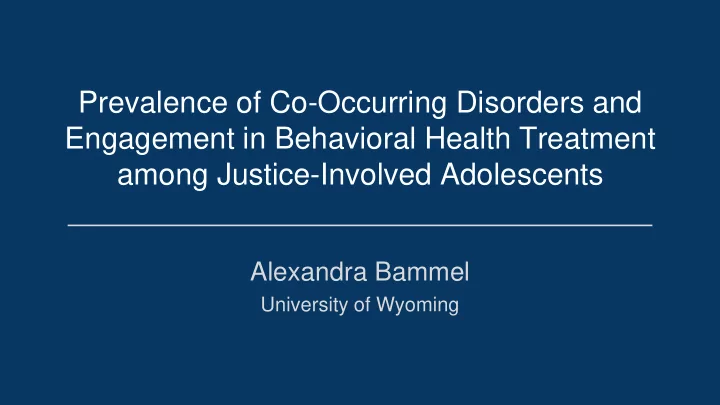

Prevalence of Co-Occurring Disorders and Engagement in Behavioral Health Treatment among Justice-Involved Adolescents Alexandra Bammel University of Wyoming
Background on Co-Occurring Disorders (CODs) ● Among clients in both mental health and substance abuse treatment settings, CODs are the rule, not the exception ● Persons with CODs: ○ Have poorer outcomes ○ Face greater difficulties related to treatment engagement and retention ○ Are more likely to be involved in the criminal justice system ● High rates of CODs among justice-involved individuals highlight the justice system as an opportunity for treatment engagement
Adolescents with CODs in the Criminal Justice System ● In 2016, juveniles represented close to 8% of all arrestees ● Several studies examining adolescents in the criminal justice system estimate about a third to have CODs ● Gap in literature using large-scale data
Key Questions ● How do justice-involved adolescents who have CODs differ from non- justice-involved adolescents who have CODs? ● For adolescents with CODs, how does being involved in the justice system affect one’s chances of receiving treatment? ○ Mental health treatment ○ Substance abuse treatment
Method ● Sample: ○ 41,579 non-institutionalized adolescents aged 12 or older ○ Surveyed by 2015-2017 National Survey on Drug Use and Health (NSDUH) ● Measures: ● Analyses: ○ ○ Substance use disorder Conducted using Stata v. 15 ○ ○ Major depressive episode Two-way tabulations ○ ○ Mental health treatment Weighted Chi-Square analyses ○ ○ Substance abuse treatment Logistic regressions ○ ○ Justice involvement Weighted for population
Results p = 0.000
Results p = 0.000
Results ( p = 0.127) ( p = 0.000) ( p = 0.000) p = 0.000
Conclusions ● Treatment needs for adolescents with CODs are great, even within the justice system ● Substance abuse treatment should be prioritized
Limitations & Ideas for Future Study Limitations: ● Sample of adolescents with CODs limited to those with past-year substance use disorder and past-year major depression ● Sample limited to non-institutionalized individuals Ideas for Future Study: ● The NSDUH should assess mental health in adolescents as comprehensively as it does adults Policy Implications: ● Federal mandates should guarantee the availability of substance abuse treatment to those in criminal justice facilities that need it
Acknowledgements Dr. Kimberly Johnson University of South Florida Dr. Roger H. Peters University of South Florida Dr. Narina Nuñez University of Wyoming
Works Cited 1. Drake, R.E., Mueser, K.T., & Brunette, M.F. (2007). Management of persons with co-occurring severe mental illness and substance use disorder: Program implications. World Psychiatry, 6 (3), 131-136. 2. Harris, K. M. & Edlund, M. J. (2005). Use of mental health care and substance abuse treatment among adults with co-occurring disorders. Psychiatric Services , 56(8), 954 – 959. https://doi.org/10.1176/appi.ps.56.8.954 3. Substance Abuse and Mental Health Services Administration (SAMHSA). (2009). Integrated Treatment for Co-Occurring Disorders: Building Your Program. DHHS Pub. No. SMA-08-4366, Rockville, MD: Center for Mental Health Services, Substance Abuse and Mental Health Services Administration, U.S. Department of Health and Human Services. 4. Watkins, K.E., Hunter, S.B., Wenzel, S.L., Tu, W., Paddock, S.M., Griffin, A., & Ebener, P. (2004). Prevalence and characteristics of clients with co-occurring disorders in outpatient substance abuse treatment. The American Journal of Drug and Alcohol Abuse, 30 (4), 749-764. 5. Aharonovich, E., Liu, X., Nunes, E., & Hasin, D.S. (2002). Suicide attempts in substance abusers: Effects of major depression in relation to substance use disorders. American Journal of Psychiatry, 159 (9), 1600-1602. 6. Dickey, B., Normand, S.T., Weiss, R.D., Drake, R.E., & Azeni, H. (2002). Medical morbidity, mental illness, and substance use disorders. Psychiatric Services, 53 (7), 861-867. https://doi.org/10.1176/appi.ps.53.7.861 7. Osher, F.C., Goldberg, R.W., McNary, S.W., Swarts, M.S., Essock, S.M., Butterfield, M.I., Rosenberg, S.D., & the Five-Site Health and Risk Study Research Committee. (2003). Blood- borne infections and persons with mental illness: Substance abuse and the transmission of hepatitis C among persons with severe mental illness. Psychiatric Services, 54 (6), 842-847. https://doi.org/10.1176/appi.ps.54.6.842 8. Claus, R.E. & Kindleberger, L.R. (2011). Engaging substance abusers after centralized assessment: Predictors of treatment entry and dropout. Journal of Psychoactive Drugs, 34 (1), 25-31. https://doi.org/10.1080/02791072.2002.10399933 9. Small, L.F. (2010) Use of mental health services among people with co-occurring disorders and other mental health comorbidities: Employing the behavioral model of vulnerable populations. Mental Health and Substance Use, 3 (2), 81-93. https://doi.org/10.1080/17523281003717871
Works Cited 10. Baillargeon, J., Penn, J. V., Knight, K., Harzke, A. J., Baillargeon, G., & Becker, E. A. (2009). Risk of reincarceration among prisoners with co-occurring severe mental illness and substance use disorders. Administration and Policy in Mental Health and Mental Health Services Research, 37 (4), 367 – 374. https://doi.org/10.1007/s10488-009-0252-9 11. Balyakina, E., Mann, C., Ellison, M., Sivernell, R., Fulda, K. G., Sarai, S. K., & Cardarelli, R. (2013). Risk of Future Offense Among Probationers with Co-occurring Substance Use and Mental Health Disorders. Community Mental Health Journal, 50 (3), 288 – 295. https://doi.org/10.1007/s10597-013-9624-4 12.National Drug Court Institute (NDCI). (2013). Drug Court Practitioner Fact Sheet: Six Steps to Improve Your Drug Court Outcomes for Adults with Co-Occurring Disorders [Fact sheet]. Retrieved from https://ndcrc.org/resource/six-steps-to-improve-your-drug-court-outcomes-for-adults-with-co-occurring-disorders/ 13. Skowyra, K.R. & Cocozza, J.J. (2007). Blueprint for Change: A Comprehensive Model for the Identification and Treatment of Youth with Mental Health Needs in Contact with the Juvenile Justice System . Delmar, NY: The National Center for Mental Health and Juvenile Justice Policy Research Associates, Inc. 14. Puzzanchera, C. (2018). Juvenile Arrests, 2016 . Laurel, MD: Office of Juvenile Justice and Delinquency Programs. 15. U.S. Department of Justice. (2017). Crime in the United States, 2016 . Retrieved from https://ucr.fbi.gov/crime-in-the-u.s/2016/crime-in-the-u.s.-2016/topic-pages/persons-arrested.pdf 16. Robertson, A. A., Dill, P. L., Husain, J., & Undesser, C. (2004). Prevalence of Mental Illness and Substance Abuse Disorders Among Incarcerated Juvenile Offenders in Mississippi. Child Psychiatry and Human Development, 35 (1), 55 – 74. 17. StataCorps, 2017. Stata statistical software. Release 15.1. College Station, TX: StataCorp LLC.
Thank you!
Recommend
More recommend